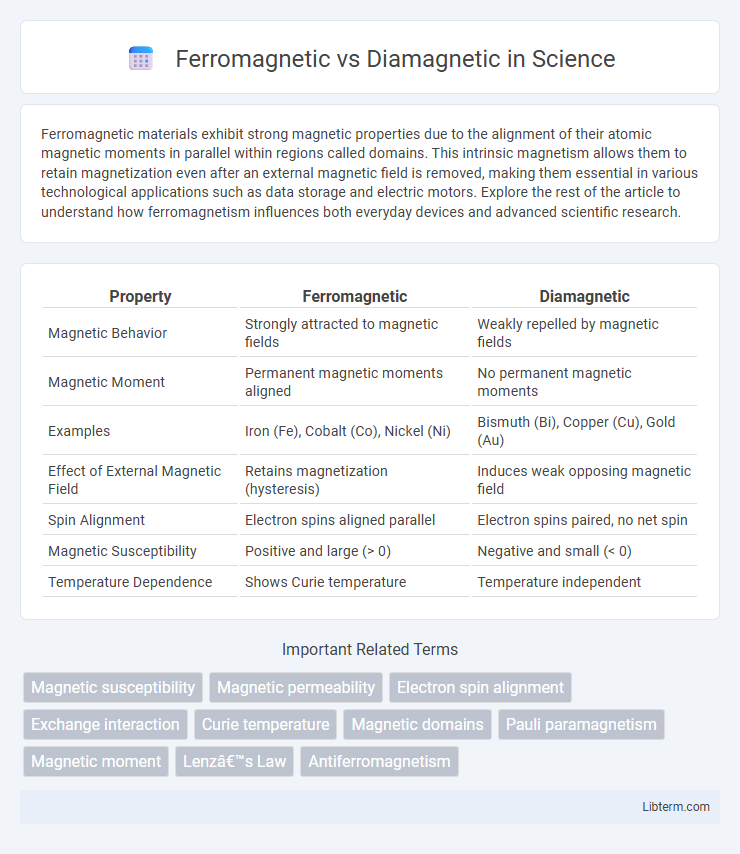Ferromagnetic materials exhibit strong magnetic properties due to the alignment of their atomic magnetic moments in parallel within regions called domains. This intrinsic magnetism allows them to retain magnetization even after an external magnetic field is removed, making them essential in various technological applications such as data storage and electric motors. Explore the rest of the article to understand how ferromagnetism influences both everyday devices and advanced scientific research.
Table of Comparison
| Property | Ferromagnetic | Diamagnetic |
|---|---|---|
| Magnetic Behavior | Strongly attracted to magnetic fields | Weakly repelled by magnetic fields |
| Magnetic Moment | Permanent magnetic moments aligned | No permanent magnetic moments |
| Examples | Iron (Fe), Cobalt (Co), Nickel (Ni) | Bismuth (Bi), Copper (Cu), Gold (Au) |
| Effect of External Magnetic Field | Retains magnetization (hysteresis) | Induces weak opposing magnetic field |
| Spin Alignment | Electron spins aligned parallel | Electron spins paired, no net spin |
| Magnetic Susceptibility | Positive and large (> 0) | Negative and small (< 0) |
| Temperature Dependence | Shows Curie temperature | Temperature independent |
Introduction to Magnetic Properties of Materials
Ferromagnetic materials, such as iron, cobalt, and nickel, exhibit strong attraction to magnetic fields due to the alignment of magnetic moments in the same direction, resulting in permanent magnetization. Diamagnetic materials, including copper, gold, and bismuth, produce an induced magnetic field in the opposite direction when exposed to an external magnetic field, causing a weak repulsion. Understanding these distinct magnetic properties is essential for applications in data storage, magnetic sensors, and electromagnetic devices.
What Are Ferromagnetic Materials?
Ferromagnetic materials, such as iron, cobalt, and nickel, exhibit strong magnetic properties due to the alignment of magnetic moments within their atomic structure, resulting in spontaneous magnetization. These materials retain their magnetization even in the absence of an external magnetic field, distinguishing them from diamagnetic materials that only exhibit weak, negative susceptibility to magnetic fields. The unique electron configuration and exchange interactions in ferromagnetic materials enable their widespread use in permanent magnets, magnetic storage devices, and electromagnetic applications.
What Are Diamagnetic Materials?
Diamagnetic materials are characterized by their negative magnetic susceptibility, meaning they create an induced magnetic field in the opposite direction when exposed to an external magnetic field. These materials, such as copper, bismuth, and graphite, do not retain magnetization and exhibit weak repulsion to magnetic fields. Diamagnetism arises from the paired electrons in their atomic structure, causing a weak, temporary magnetic response that contrasts with the permanent magnetization found in ferromagnetic materials like iron and cobalt.
Key Differences Between Ferromagnetic and Diamagnetic
Ferromagnetic materials, such as iron, cobalt, and nickel, exhibit strong attraction to magnetic fields due to the alignment of magnetic moments in the same direction, resulting in permanent magnetism. Diamagnetic materials, including copper, silver, and bismuth, create an induced magnetic field in the opposite direction when exposed to an external magnetic field, causing a weak repulsion. The key differences lie in their magnetic susceptibility: positive and large for ferromagnets indicating strong attraction, and negative and very small for diamagnets indicating weak repulsion.
Electron Structure and Magnetic Behavior
Ferromagnetic materials have unpaired electrons in their electron structure, allowing electron spins to align parallel and create strong magnetic domains, leading to permanent magnetism. Diamagnetic materials contain only paired electrons, resulting in no net magnetic moment and weak repulsion from magnetic fields. The electron configuration fundamentally determines magnetic behavior, with ferromagnetism arising from exchange interactions between unpaired spins and diamagnetism caused by induced currents opposing applied magnetic fields.
Common Examples of Ferromagnetic and Diamagnetic Materials
Ferromagnetic materials, such as iron, cobalt, and nickel, exhibit strong magnetic properties due to the alignment of magnetic domains, making them widely used in permanent magnets and electronic devices. Diamagnetic materials like bismuth, copper, and silver demonstrate weak repulsion to magnetic fields because their electrons create tiny opposing magnetic moments. Understanding these common examples helps in selecting appropriate materials for applications in magnetic storage, sensors, and electromagnetic shielding.
Applications of Ferromagnetic Materials
Ferromagnetic materials, characterized by their strong attraction to magnetic fields and ability to retain magnetization, are essential in manufacturing permanent magnets, transformers, and electric motors. Their high magnetic permeability makes them ideal for magnetic storage devices and inductors, enhancing efficiency in electronic circuits. The stability of their magnetic domains under varying external fields supports applications in magnetic sensors and data storage technologies.
Uses of Diamagnetic Materials
Diamagnetic materials are widely used in magnetic levitation applications due to their ability to create repulsive magnetic fields that stabilize levitated objects without requiring external power. These materials also find use in precision measurement instruments, such as magnetic resonance imaging (MRI) and magnetic sensors, where their weak repulsion minimizes interference with strong external magnetic fields. Furthermore, diamagnetic substances are crucial in shielding sensitive electronic components from stray magnetic fields, enhancing the performance and reliability of devices in medical and scientific environments.
Influences on Magnetic Susceptibility
Ferromagnetic materials exhibit strong positive magnetic susceptibility due to the parallel alignment of magnetic domains, resulting in permanent magnetization even without an external field. Diamagnetic materials, in contrast, show a weak negative magnetic susceptibility as their induced magnetic moments oppose the applied magnetic field, caused by electron orbital motion. The difference in magnetic susceptibility between these materials is primarily influenced by their electron spin configurations and atomic structure.
Summary: Choosing Between Ferromagnetic and Diamagnetic
Ferromagnetic materials exhibit strong, permanent magnetization due to aligned magnetic moments, making them ideal for data storage, electric motors, and magnetic sensors. Diamagnetic materials create weak, negative susceptibility to magnetic fields and are best suited for applications requiring magnetic levitation or sensitive magnetic field detection without residual magnetism. Selecting between ferromagnetic and diamagnetic substances depends on the need for permanent magnetization versus minimal magnetic interaction.
Ferromagnetic Infographic

 libterm.com
libterm.com